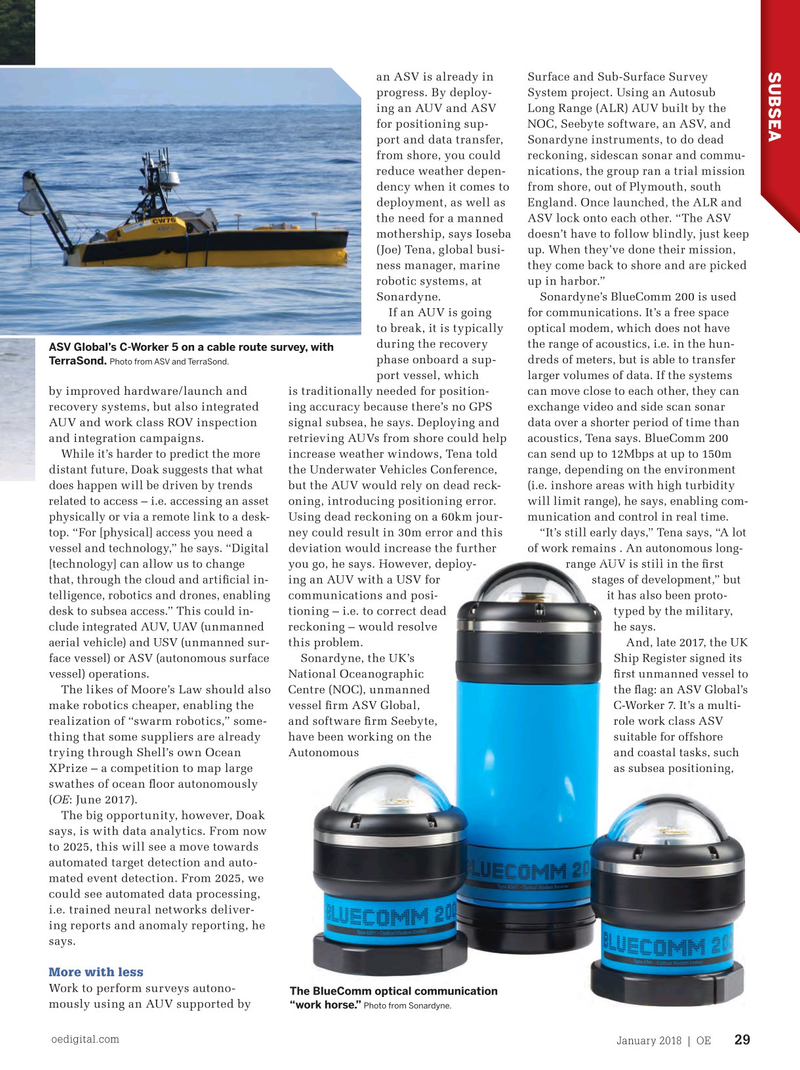
Page 27: of Offshore Engineer Magazine (Jan/Feb 2018)
Read this page in Pdf, Flash or Html5 edition of Jan/Feb 2018 Offshore Engineer Magazine
SUBSEA an ASV is already in Surface and Sub-Surface Survey progress. By deploy-
System project. Using an Autosub ing an AUV and ASV
Long Range (ALR) AUV built by the
NOC, Seebyte software, an ASV, and for positioning sup- port and data transfer,
Sonardyne instruments, to do dead from shore, you could reckoning, sidescan sonar and commu- nications, the group ran a trial mission reduce weather depen- from shore, out of Plymouth, south dency when it comes to deployment, as well as
England. Once launched, the ALR and
ASV lock onto each other. “The ASV the need for a manned mothership, says Ioseba doesn’t have to follow blindly, just keep up. When they’ve done their mission, (Joe) Tena, global busi- ness manager, marine they come back to shore and are picked up in harbor.” robotic systems, at
Sonardyne’s BlueComm 200 is used
Sonardyne.
If an AUV is going for communications. It’s a free space to break, it is typically optical modem, which does not have during the recovery the range of acoustics, i.e. in the hun-
ASV Global’s C-Worker 5 on a cable route survey, with phase onboard a sup- dreds of meters, but is able to transfer
TerraSond.
Photo from ASV and TerraSond.
port vessel, which larger volumes of data. If the systems by improved hardware/launch and is traditionally needed for position- can move close to each other, they can recovery systems, but also integrated ing accuracy because there’s no GPS exchange video and side scan sonar
AUV and work class ROV inspection signal subsea, he says. Deploying and data over a shorter period of time than and integration campaigns. retrieving AUVs from shore could help acoustics, Tena says. BlueComm 200
While it’s harder to predict the more increase weather windows, Tena told can send up to 12Mbps at up to 150m distant future, Doak suggests that what the Underwater Vehicles Conference, range, depending on the environment does happen will be driven by trends but the AUV would rely on dead reck- (i.e. inshore areas with high turbidity related to access – i.e. accessing an asset oning, introducing positioning error. will limit range), he says, enabling com- physically or via a remote link to a desk-
Using dead reckoning on a 60km jour- munication and control in real time. top. “For [physical] access you need a “It’s still early days,” Tena says, “A lot ney could result in 30m error and this vessel and technology,” he says. “Digital of work remains . An autonomous long- deviation would increase the further [technology] can allow us to change range AUV is still in the ? rst range AUV is still in the ? rst you go, he says. However, deploy-you go, he says. However, deploy- that, through the cloud and arti? cial in- stages of development,” but stages of development,” but ing an AUV with a USV for ing an AUV with a USV for telligence, robotics and drones, enabling it has also been proto-it has also been proto- communications and posi-communications and posi- desk to subsea access.” This could in- typed by the military, typed by the military, tioning – i.e. to correct dead tioning – i.e. to correct dead clude integrated AUV, UAV (unmanned he says. he says. reckoning – would resolve reckoning – would resolve aerial vehicle) and USV (unmanned sur- And, late 2017, the UK And, late 2017, the UK this problem. this problem.
Sonardyne, the UK’s face vessel) or ASV (autonomous surface Sonardyne, the UK’s Ship Register signed its Ship Register signed its
National Oceanographic vessel) operations. National Oceanographic ? rst unmanned vessel to ? rst unmanned vessel to
The likes of Moore’s Law should also Centre (NOC), unmanned Centre (NOC), unmanned the ? ag: an ASV Global’s the ? ag: an ASV Global’s vessel ? rm ASV Global, vessel ? rm ASV Global, C-Worker 7. It’s a multi-C-Worker 7. It’s a multi- make robotics cheaper, enabling the and software ? rm Seebyte, and software ? rm Seebyte, role work class ASV role work class ASV realization of “swarm robotics,” some- have been working on the have been working on the suitable for offshore suitable for offshore thing that some suppliers are already
Autonomous Autonomous and coastal tasks, such and coastal tasks, such trying through Shell’s own Ocean
XPrize – a competition to map large as subsea positioning, as subsea positioning, swathes of ocean ? oor autonomously (OE: June 2017).
The big opportunity, however, Doak says, is with data analytics. From now to 2025, this will see a move towards automated target detection and auto- mated event detection. From 2025, we could see automated data processing, i.e. trained neural networks deliver- ing reports and anomaly reporting, he says.
More with less
Work to perform surveys autono-
The BlueComm optical communication mously using an AUV supported by “work horse.” Photo from Sonardyne.
oedigital.com
January 2018 | OE 29 028_OE0118_Subsea1_AUV-ROV.indd 29 12/27/17 6:56 PM

 26
26

 28
28